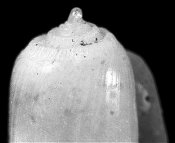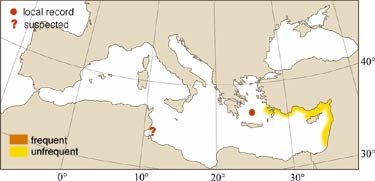

|
Relevant Synonyms
Misidentification
|
|
| photos: G. Buzzuro - E. Greppi / S. Gofas |
|
SHORT
DESCRIPTION
color :
white.
common size :
up to 5.4 mm. |
DISTINGUISHING CHARACTERISTICS
BIOLOGY / ECOLOGY
habitat :
this species seems to live in soft bottoms at a moderate depth. |
|
1st
Mediterranean record
|

|
|
DISTRIBUTION
|
ESTABLISHMENT SUCCESS
speculated reasons for success :
|
|
|
MODE OF
INTRODUCTION |
IMPORTANCE TO
HUMANS |
|
KEY
REFERENCES
|
|
|
 Bulla mucronata Philippi, 1849
Bulla mucronata Philippi, 1849